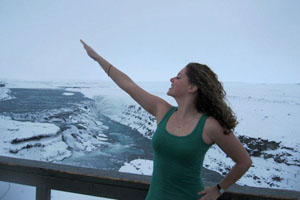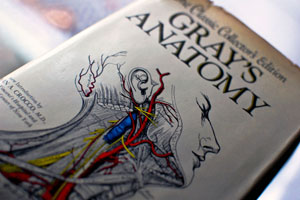January 27, 2014 - By John Sanford
"SMS Unplugged," a new series on Stanford Medicine's blog, Scope, was launched earlier this month. (SMS refers to "Stanford medical students.")
Each week, a medical student will publish an entry chronicling his or her unique experiences. As first-year student Hamsika Chandrasekar writes in the inaugural entry, "Every medical student has a number of amazing, humbling 'firsts. … These are moments that should be captured, frequently revisited, and never forgotten.
"This ambition to reflect on medical school and related experiences is the inspiration for 'SMS Unplugged.' …The goal is simply to share our stories, with anyone who might be interested, and when we graduate with MDs, to remember what inspired, humbled, and motivated us along the way."
The two subsequent entries, by Natalia Birgisson and Mihir Gupta, are reprinted here.
***
Basement floods, ski lifts and Christmas cookies: Life lessons from winter break

Natalia Birgisson, a first-year medical student, describes spending time with family members in Iceland over Christmas.
Going home for the holidays means trekking to a small town in northern Iceland for Christmas, and then to the suburb of Miami known as Little Cuba for the New Year. As with so many 21st-century families, my parents are happily divorced and remarried. I have every kind of sibling known to the English language — full, half, step, and ex-foster siblings total eight loved ones I pray for before bed.
Every December, I land in Iceland having slept little, eaten less and inevitably forgotten my winter coat. But I land at home. This is a place where scathing water bubbles to the surface of the land so hot it is piped into houses at 194 degrees Fahrenheit. Here like nowhere else can you take an endlessly long, hot shower without feeling guilty.
In fact, the Christmas that we installed a hot tub in our backyard, my stepmom joked that we could fill it with hot water from the hose since the plumber hadn't arrived. I was out cross-country skiing to my grandparents' for cookies and tea when my dad made good on her joke.
A while later, when I was back home and showering after my excursion, my sister Tatiana forced the lock on the bathroom door open. She pulled me out of the shower, threw a towel at me and barreled past with a bucket of dirty water. As she dumped the water into the shower, she shouted at me to get dressed. Dad had flooded the basement.
I walked out in my towel and joined the assembly line that my family had formed. My dad stood at the front, passing up buckets of water as he sloshed through the basement in his fishing boots. Petra, my stepsister, flashed jokes that had us laughing as we spent the afternoon clearing the basement.
This year's Christmas adventure was learning to snowboard. Dad woke us up every morning as soon as the lights on the ski slopes turned on. Luckily, my sister, Helga, is still only 7, so she doesn't last more than a few hours.
The second day, Petra and I almost crushed Helga when we all fell off the ski lift. We came home for lunch and my little brother, Birgir, regaled my dad and stepmom with stories of how we survived. After lunch I walked through the basement to put the helmets away and passed the buckets we'd used to clear the basement flood. I touched the jacket I'd worn when Dad and I biked through the highlands and the game of Trivial Pursuit that my stepbrother, Asgeir, always wins. I smiled thinking how this home is filled with memories of childhood and love.
And it dawned on me that I have been so busy with medical school, I forgot about my dreams outside of medicine. For I dream that I will become a gifted surgeon, able to help heal those in need. I dream that I will work in developing countries and leave my mark upon the world. And while I have those dreams, I also dream that some day my own basement will flood and my children will laugh as they run around in the mess. I dream that someday my children's children will visit me on their own for tea and cookies.
Returning for winter quarter, I'm thankful my family continues to ground me amidst the whirlwind of Stanford medical school. I'm thankful they remind me every time I come home that the greatest accomplishment of my life will be to raise a family of my own whose laughter rings in the memories that fill our home.
Natalia Birgisson is a first-year medical student. She is half Icelandic, half Venezuelan. She is interested in neurosurgery, global health and ethics. She loves running and baking; when she's lucky, the two activities even out.
***
You are what you read: The academic diet of the 21st-century medical student

Mihir Gupta discusses the widespread preference among medical students today for streamlined print and digital resouces, rather than the traditional tomes of the discipline.
A recent survey published in H&P, the Stanford medical school magazine, asked 20 graduating students to recommend books to read during the clinical rotation in internal medicine. Surprisingly, the top vote-getters weren't books at all. The two most popular resources were both banks of practice questions, while the next two included a review book and a pocket handbook. (The top four resources: MKSAP question book, USMLE World question bank, Step Up To Medicine review book and Pocket Medicine.)
"Is this how our students learn the subtleties of sickness and health? What happened to textbooks? We had to read Harrison's Principles of Internal Medicine cover to cover!" remarked one professor after reading the survey.
For what it's worth, Harrison's did receive one vote in the survey. But the results reveal a profound generational change in how medical students are learning the fundamentals of human health and disease. The recent explosion of printed and digital resources offers students alternatives to the classic texts that previous generation swore by. As a result, medical tomes are no longer the primary means by which students learn medicine, but just one piece of an increasingly complex puzzle.
Medical school is often compared to drinking from a fire hose; the student's job is to imbibe as much knowledge as possible without getting bowled over. This is not a new phenomenon. Western physicians have been producing vast compendia of knowledge for millennia. The ancient Greek physician Galen published hundreds of treatises, aided by an army of scribes and students who recorded his every word while he saw patients.
The modern academic physician also leads an entourage of student doctors during daily rounds. But instead of scribing away on scrolls or stone tablets, today's trainees scroll through their web browser on tablet devices. While one resident looks up drug dosing on UpToDate, her colleague consults Diagnosaurus to make sure he didn't miss anything in the differential diagnosis. Meanwhile, the medical student quickly does a practice question on the USMLE World online question bank to test if he really understands the treatment algorithm.
The shift away from voluminous texts starts early in medical school, when the first exams come up before any of us has made it all the way through Gray's Anatomy. Students opt for streamlined review books and digital resources in part because they are, well, streamlined and digital. Instead of reading about each step in the Krebs cycle, download an app with vivid pictures and animations. Instead of lugging a cardiology textbook to the library, go for a run while listening to a podcast about congestive heart failure. And if Google doesn't have the answer, consult the online version of Robbins Pathology (soon to be powered by Google).
Students also point out that reading textbooks is "passive learning," which many studies have shown to be less effective than "active learning," such as answering quiz questions. Others may want to tailor resources to their individual learning styles; Visual learners frequent websites like SketchyMedicine and Picmonic, audiophiles stock up on lectures from iTunes U. Medical schools (including Stanford) even collaborate with web-based platforms like Khan Academy to digitize their curriculum.
The generational shift in learning styles is a source of consternation to at least a few senior physicians. I recall one clinician who helped us examine a patient in respiratory distress and then quipped, "There is NOT an app for that." In another instance, an exasperated consultant asked a resident, "Do I need to draw you a picture?!" — and was shocked when the resident replied (without a hint of sarcasm), "That would be great; I'm really a visual learner."
I have also heard faculty say that trainees must "earn it to learn it." Wading through Robbins and Harrison's makes students confront the sheer depth and breadth of medical knowledge, and ultimately imparts a more nuanced understanding of human disease. As one surgery faculty put it, "would you really want your life in the hands of a doctor who aced his multiple-choice boards questions but hasn't read a textbook?"
The truth is likely somewhere in between. Innovative digital resources are vital for helping students retain knowledge and simplify difficult concepts. As long as there are multiple-choice board exams, there will be demand for streamlined review books that distill high-yield content. But Harrison's isn't going away anytime soon, nor should it. There will always be a need for textbooks to provide comprehensive information. And even the most committed app aficionados among us will eventually make it through those books — just maybe not during internal medicine rotation.
Mihir Gupta is a third-year medical student. He grew up in Minnesota and attended Harvard College. Prior to writing for Scope, Mihir served as co-editor in chief of H&P, the Stanford medical school student journal.
About Stanford Medicine
Stanford Medicine is an integrated academic health system comprising the Stanford School of Medicine and adult and pediatric health care delivery systems. Together, they harness the full potential of biomedicine through collaborative research, education and clinical care for patients. For more information, please visit med.stanford.edu.